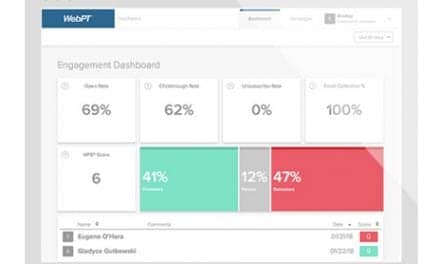There are many options for software designed to aid physical therapy clinics in managing their practices, which can make winnowing down the list of ideal candidates a daunting task. With this in mind, Physical Therapy Products put together this roundtable of software manufacturers to discuss their perspective on ways PT clinics can streamline their process for purchasing practice management software.
Participants include Sharif Zeid, business director, MWTherapy; Zack Butterfield, sales director, private practice therapy, Net Health; Tom Kero, client development executive, Netsmart Technologies Inc; Steven Presement, president, Practice Perfect EMR; Allison Jones, vice president of marketing, Raintree; and Heidi Jannenga, PT, DPT, ATC, co-founder and chief clinical officer, WebPT.
What are some tips for how to prioritize a PT clinic’s wish list of practice management software features?
Sharif Zeid (MWTherapy): The best way to do this is to make sure you have open communication with each constituency in the practice. This would typically include groups like owners, managers, therapists, front desk, and billers. Each group should make a list of things they need to have, things they’d like to have, and things they don’t want to see. This information can then be used to build a complete list that will make evaluating software easier, faster, and more productive.
Zack Butterfield (Net Health): I would encourage PT clinic leaders to think about their vision of success, then ask, “What kind of solution will help me get there?” It’s important to prioritize features that support your clinic’s overall goals. Look for the solution offering the most comprehensive feature set. You don’t want to end up juggling multiple tools and systems to make up for gaps in features that your clinic needs. Remember, this is an investment in your clinic; if you are focused only on minimizing costs, you’ll likely get what you pay for.
Tom Kero (Netsmart): I have been selling TheraOffice for 20+ years and to this day, some of the top things that prospects should think about remain the same: what has the biggest effect on revenue, what are the biggest needs of the staff, what will save staff the most time, and what can be done to enhance the patient experience (i.e. online scheduling, online bill pay, etc.). Additionally, identifying the prospect’s biggest pain point and explaining how TheraOffice can help remedy that is key. At the end of the day, potential clients are looking to make a change for a reason, and it is important to keep that reason at the forefront of the conversation when purchasing practice management software.
Steven Presement (Practice Perfect): It’s important to remember that there are several stakeholders in selecting an application such as this – clinicians, administrative staff, and potentially billers. ALL must consider the options and have an opportunity to voice their concerns. Many times we find that the clinicians rule the roost, and the chosen application is fantastic for them, but leaves the admin people cold. We have also found that any stakeholder not involved in the decision-making process is less likely to be invested in adopting the chosen application, which will, in turn, ripple into grief for all parties concerned.
Allison Jones (Raintree): I would say it is twofold: every clinic wants to grow business, profit, and reach. So, the first would be leveraging our platform to achieve those goals. At the same time, streamlining your business and daily workflow. Raintree’s software features are meant to work together, so building upon growth with integrated patient engagement tools, then billing with precision with automated workflows, will only maximize their return once they come on board with Raintree.
Heidi Jannenga (WebPT): PT clinics can prioritize their wish list considering their business goals and their clinic workflows. Ultimately, the software should be easy to use and help save time so PTs can do what they do best—treat patients. As a baseline, features should enable the clinic to: securely share patients progress and chart with their care team; document defensibly with in-note payer compliance alerts; easily use tools and integrations for therapy threshold tracking, MIPS reporting, and 8-minute rule monitoring; and streamline documentation with carry-forward functionality and easy note switching.
What questions do potential customers ask you the most when considering whether to purchase your practice management software products?
Sharif Zeid (MWTherapy): The most common questions we get are around features and pricing. Practices that are considering using our EMR really want to know what it offers, sometimes in great detail, and they want transparent and open pricing that shows them what they’ll be paying going forward. We really pride ourselves on making sure we take the time to get all the questions and needs answered.
Zack Butterfield (Net Health): Potential customers often ask me about how our solution can help them meet their long-term, growth-related goals. They are always thinking about how their clinics can be more efficient, and they want to know about the functionality in our solution that supports those efforts.
Tom Kero (Netsmart): Some of the most common questions prospects ask revolve around accessibility, customization options, and if the solution is “completely integrated.” Clients want to be able to access the software from anywhere, customize it to fit their workflow, and have it be “all-in-one.” The fewer systems users have to log into, the better. Another common question is whether the software can grow with their practice. This can include hiring additional staff members and opening satellite locations. Lastly, questions always come up regarding pricing and the implementation/support processes.
Steven Presement (Practice Perfect): Everyone asks about pricing, obviously. While features, capabilities, etc, are of key concern, if a product is priced way out of line, it doesn’t matter how good it is, it just may not be justifiable. Big clinic, small clinic, it doesn’t matter, pricing is certainly a universal concern when purchasing practice management software.
Allison Jones (Raintree): The most common question we get is how do we handle complex billing situations. Originally designed for billing companies, Raintree has commercial-level features and functionality to simplify the entire RCM process. Based on an exception-based model, the system flags follow-up based on claim data points that fall outside of the norm. This model along with high levels of automation allows billers to manage 2-4 times as many claims per month as a typical biller.
Heidi Jannenga (WebPT): There are three questions we get asked the most at WebPT.
- Does it help with compliance? In a landscape of constantly changing rules and regulations, it’s important to have a practice management software that not only helps you stay compliant, but streamlines work and helps you get paid faster. WebPT automatically updates the application every time the rules change so clinics can be sure they are always up to date.
- Is it specifically for rehab therapy and does it support specializations? WebPT was built by, and for, rehab therapists and so it aligns with rehab therapy workflows, allowing PTs to easily create custom evals, complete auto-scored outcome measurement tools, and choose from the most current evidence-based tests available. WebPT also offers specialty specific workflows for occupational therapy, speech language pathology, pediatric physical therapy, and pelvic health therapy.
- Is it customizable? Pre-built templates make documentation easy, but PTs also have the option to add their own workflows, templates, and integrations to work within their own unique business processes.
Are there factors that may change the criteria to consider and which questions to ask about practice management software, such as the size of a practice?
Sharif Zeid (MWTherapy): There are always different considerations depending on the practice. Certainly a 100-person practice would have different questions than a 5-person practice. With that said, we really see that the team setup and workflow that a practice uses would be more relevant to the criteria they may use to evaluate an EMR like MWTherapy. Some may have a dedicated billing team while others use an outsourced biller. The structure of the practice is central to asking the right questions and getting the answers needed.
Zack Butterfield (Net Health): Practice size and types of specialty services offered will largely determine what questions a clinic asks. For example, a startup with one location will be interested in how the practice management solution can help them grow and scale. A large enterprise organization will want to ensure the solution can help them uphold gold standards for documentation and billing across multiple locations. The varying job roles and responsibilities of a practice’s staff are important to consider. Billing is crucial to a clinic’s success, so it will be important to know about the billing workflows they use if they have in-house billing.
Tom Kero (Netsmart): As we all know, no two practices are alike; hence, there are a variety of factors to consider when speaking with software vendors. A clinic’s size (start-up/small practice, medium/large practices, and enterprise/hospitals), patient population, payer mix, and specialty areas (pediatrics, lymphedema, pelvic health, etc) all have a direct effect on the questions that should be discussed during the sales process. Additionally, it is important to understand if the clinic will be mobile (ie in-home visits), have a physical location, or do a little of both. With that said, if the clinic is transitioning from a different software, it is critical to know why and determine if the software they are looking at can address their current pain points. Lastly, and perhaps most obviously, the business’s budget may put constraints on what they want compared to what they can afford.
Steven Presement (Practice Perfect): The larger the practice, the more the practice owners will have to rely on cold, hard facts and not gut instinct or guesswork. When you have 2-3 practitioners, it may be easier to keep on top of who is doing what, who is busy, who is good with the patients, who has great outcomes, and who has a low cancellation rate. But, as the practice grows, it’s impossible to keep track of some very key metrics without relying on a good practice management system. And these stats are just the tip of the iceberg.
Allison Jones (Raintree): I don’t think clinics really need to use different criteria. Raintree’s system is designed to help manage complexity within all aspects of the clinic environment. This allows staff to be more efficient so everyone can do more, treat more patients, and collect more revenue. For growing practices, Raintree can help the organization expand without having to maintain the normal cost load of staffing prior to having revenue to support the new staffing levels. Raintree has shown that growing practices can reduce staffing costs by as much as 30%. We like to say that Raintree is the all-in-one EMR that you’ll never outgrow.
Heidi Jannenga (WebPT): Important criteria to consider include the types of payers your clinic works with. Whether a clinic works with private payers, Medicare, or is cash-based, there are many WebPT solutions that can make documentation, compliance, and billing a breeze. It’s important to know what your payer billing, reporting, and compliance requirements are so that you can find the solution that best fits your needs.
What product features do you get asked about most by potential customers?
Sharif Zeid (MWTherapy): We aim to serve the modern practice with our all-in-one. The majority of customers are highly interested in our patient portal, our comprehensive reporting, customizable documentation, and marketing automation. The market continues to evolve as patient expectations grow and, in turn, practice expectations grow. We’re super excited to keep expanding on our offerings and bringing new features to market constantly.
Zack Butterfield (Net Health): Potential customers want to hear about the important areas of functionality that make up a valuable EMR: documentation, compliance, billing, reporting, and scheduling.
Tom Kero (Netsmart): The top three things that we get asked all have to do with enhancing the patient experience. Thanks to the COVID-19 pandemic, practices are seeking more and more ways to have patients be self-serve. As a result, prospects tend to ask about patient portals, online payment options, and home exercise programs. On the staff side of things, front office workers tend to ask about appointment reminders; providers ask about documentation customization options such as evaluation templates, treatments, and protocols; and billers ask about clearinghouse integrations.
Steven Presement (Practice Perfect): This has changed over the years. The questions used to be more around the clinical side of the things: how customizable, how user-friendly. Now it’s become more about the client interaction: Do you have two-way texting, can patients fill out forms online, can I exchange documents with my patients, can they access their accounts online? We’ve definitely seen a shift to questions regarding both patient self-service and the ability to communicate securely with the patient.
Allison Jones (Raintree): “Do you have robust reporting capabilities?” We get asked this often. Raintree has one of the most comprehensive libraries of standard reports with a powerful report builder for custom reports. This is also backed by business intelligence and advanced analytics tools that help clients understand the performance of their business by analyzing KPIs across key financial and operational data points. In addition, we get asked about the workflow, how our system empowers patient engagement, and what else we could expect for accountability in non-clinical job roles. Essentially, how integrated is it, and how user-friendly it is.
Heidi Jannenga (WebPT): No matter the clinic size, PTs are always looking for better ways to engage their patients, which is why home exercise program (HEP) solutions are at the top of the list for WebPT members. WebPT HEP helps patients achieve their therapy goals by providing easy-to-access videos in an intuitive interface for mobile and tablet, while also supporting PTs with the tools they need to encourage plan adherence and patient engagement. For example, WebPT members receive updates when patients view their exercise videos, log activities, and complete exercises and plans. Plus, they can securely chat back and forth and send reminders, thus ensuring patients are always confident with their exercise plans.
What criteria do you wish potential customers would think about more when weighing their practice management software options?
Sharif Zeid (MWTherapy): We are here to support practices in their journey to selecting an EMR. Every week we see many practices taking a thoughtful approach to considering different products including MWTherapy. If we were to make a suggestion, it would just be to recognize that making a decision on a singular feature rarely works out. The ideal situation is to take all the needs in balance to find the best overall solution for all constituencies.
Zack Butterfield (Net Health): I wish more potential customers would consider how the software is going to empower their clinic to be successful, rather than just thinking about the costs associated with purchasing new software. I encourage potential customers to consider the return on investment and value the software can provide, such as optimized revenue and improved efficiency, outcomes, and patient engagement. Think outside of your present-day needs. Consider your long-term goals to grow and scale your clinic. And don’t forget about evaluating the vendor. Ensure they are going to be a great partner for your clinic now and down the road.
Tom Kero (Netsmart): One of the biggest things I wish clinics would think about when it comes to considering their EMR and practice management software options, would be how it will enhance revenue. Oftentimes, decision makers get caught up in the pricing in the here and now, but forget about all that they are getting and what it will do, over time, to their cash flow/patient experience. Furthermore, if a prospect has their heart set on a certain feature, workflow, or price, they usually are immediately turned off if the software does not have said feature, support said workflow, or sell for said price. I always try to remind clients about the ease of use/implementation and all that the software might be able to provide to help shed some light on the bigger picture. One feature or price should not make or break the decision. I always encourage clients to consider their business plan and goals before making a quick decision.
Steven Presement (Practice Perfect): I wish customers would think more about the end: “What happens if I leave your software?” Users don’t consider this, and if and when “the end” comes, they are stuck, blackmailed into paying forever or sticking around once they realize they are left with nothing should they part ways with their EMR provider. A key question every potential customer should ask is, “What does my access to my data look like if I am no longer paying you?”
Allison Jones (Raintree): Making it easier for the clinician. The fact that Raintree system allows a patient coordinator to check in the patient, bill them, and alert the aide or PT that their next client has arrived with a click of the mouse is seamless. Physical, occupational, speech, and ABA therapists can do their notes, speak with other offices, and provide guides for when the patient needs to do home exercises. Our job is to make the jobs of our healthcare clinicians easier. With Raintree, we strive to do that for our users.
Heidi Jannenga (WebPT): “Will this software scale as we continue to grow?” Not only does this question aptly apply to software benefits and features—as in, will it continue to support a practice at each stage of its growth—but, customers must weigh this criterion from a financial perspective, too. To this end, don’t ever settle for a solution that charges per chart, because the more patients you see, the more money you’ll owe your software vendor. In other words, you’ll be penalized for growing. WebPT, on the other hand, charges per user license. That way, the platform grows with you at a pace that’s comfortable for everyone involved.




